Abstract
In future 6G systems, integrated sensing and communication (ISAC) in the terahertz (THz) band are emerging as a key technology. Photomixing-based approaches offer advantages for the generation and control of THz waves due to their wide bandwidth and frequency tunability. This paper proposes and experimentally demonstrates a THz-band ISAC system that employs high-speed wavelength tunable lasers. Leveraging the rapid wavelength tunability of the laser, the system simultaneously generates a frequency-modulated continuous-wave (FMCW) radar signal and a frequency-shift keying (FSK) communication signal. Experimental results show successful ranging with a centimeter-level distance measurement error using a 7.9 GHz sweep-bandwidth THz-FMCW signal. The system achieves a short repetition period of 800 ns, significantly enhancing real-time performance in dynamic environments. Moreover, 2FSK communication at 2 Gbit/s was demonstrated without the use of an external modulator, achieving a BER below the HD-FEC threshold. These results confirm that radar and communication functionalities can be integrated into a single transmitter. The proposed system contributes to reducing system complexity and cost and offers a promising solution for 6G applications.
1. Introduction
In recent years, the volume of data traffic in mobile networks has been increasing exponentially [1,2]. Terahertz (THz) waves, ranging from 0.1 to 3 THz, offer significantly wider bandwidth and higher data-carrying capacity than the microwave frequencies currently used in wireless communication systems. This makes them strong candidates to serve as carrier waves in 6G communication systems [3,4,5,6,7,8]. Owing to these advantages, THz-band wireless communication has been the focus of much research in recent years [9,10,11,12,13]. In addition to their use in communication systems, THz waves have garnered attention in radar applications. On the radar side, frequency-modulated continuous-wave (FMCW) radar has attracted increasing attention due to its robustness to interference and its ability to simultaneously measure distance and velocity [14]. In applications where higher resolution is required beyond the capabilities of conventional microwave FMCW systems, the use of THz devices becomes essential due to their capability of realizing wider bandwidths. As a result, THz-band FMCW radar has seen increasing research activity [15,16,17,18,19,20].
Owing to the continued advancement of communication and radar technologies, THz waves are an ideal carrier for simultaneously achieving high-capacity communication and high-resolution ranging [21]. Consequently, integrated sensing and communication (ISAC) systems operating in the THz band are receiving growing attention and are expected to play a key role in supporting emerging applications in 6G wireless networks, with various approaches being actively investigated [22,23,24,25]. Nevertheless, challenges remain in both THz-band communication and FMCW radar. Various modulation methods for THz waves have been studied, including intensity modulation, phase modulation, and multilevel modulation combining both [26,27,28,29,30,31]. However, all of these modulation methods inevitably suffer from intensity noise [32]. Therefore, it is important to develop novel THz-wave modulation methods that are robust to intensity fluctuations. In radar applications for 6G systems, real-time performance under dynamic conditions is of critical importance. In particular, autonomous driving requires accurate estimation of distance and velocity for fast-moving vehicles.
In this paper, we propose an integrated FMCW radar and frequency-shift keying (FSK) communication system operating in the THz band. The performance comparison of the proposed THz ISAC system is presented in Table 1. In this study, we employed a photomixing-based technique for THz wave generation. Photomixing is a technique that generates an electrical signal using the square-law detection characteristic of a photodiode (PD), where the signal frequency corresponds to the difference between two optical frequencies [33]. One of the key advantages of this approach is the ease of tuning the phase and frequency of the generated THz waves. In contrast, electronic-based approaches face fundamental difficulties in achieving wide tunability in the THz band, making photomixing-based techniques more promising for ISAC applications. We demonstrate frequency modulation as a novel communication method with robustness to intensity noise in the THz band, realized through photomixing driven by high-speed wavelength tunable lasers. By leveraging the high-speed wavelength tunability of the laser source, we successfully demonstrated 2 Gbit/s 2FSK communication without the use of any external modulators. This approach is not only robust to intensity fluctuations but also advantageous for compact integration. In addition, the system generates THz-FMCW signals with frequency sweep durations on the order of hundreds of nanoseconds using a high-speed wavelength tunable laser. Unlike pulsed radar systems, this continuous and short sweep time significantly enhances real-time performance in dynamic environments compared to conventional radar. This approach achieves FMCW modulation in a simple and low-cost manner by directly tuning the laser wavelength, without requiring an arbitrary waveform generator (AWG) or any external modulators. In our experiment, ranging with centimeter-level distance measurement error was achieved. To simultaneously generate the two THz signals from a single transmitter, we employed a uni-traveling-carrier photodiode (UTC-PD) fabricated on a silicon carbide (SiC) substrate. The high thermal conductivity of SiC enables the SiC-based UTC-PD to achieve more stable operation and higher photocurrent generation compared to conventional InP-based UTC-PDs, and it demonstrated a THz output power much larger than 1 mW at 300 GHz [34]. In this way, we successfully integrated both radar and communication functionalities into a single transmitter, contributing to reduced system complexity and hardware cost.

Table 1.
Performance comparison of THz ISAC systems.
2. Key Technologies and Devices
2.1. Photomixing-Based THz Wave Generation
Photomixing is a technique that generates an alternating current signal with a frequency corresponding to the difference between two optical frequencies, based on the square-law detection characteristic of a PD. Figure 1 illustrates the configuration of THz wave generation via photomixing. As shown in the figure, optical waves from LD1 and LD2 (fixed-wavelength or tunable laser diodes) are combined and photoelectrically converted by a PD. The electric fields of the two optical waves (E1, E2) are expressed as follows:
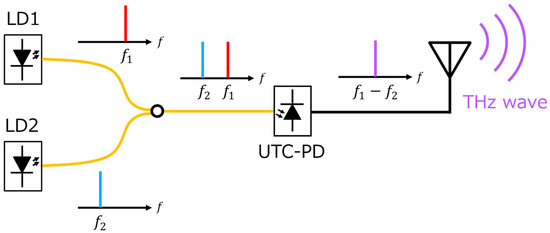
Figure 1.
Configuration of THz wave generation via photomixing.
Here, A1 and A2 are the amplitudes, f1 and f2 are the optical frequencies, and φ1 and φ2 are the initial phases, respectively. When the two lightwaves are combined and injected into a UTC-PD [35], a photocurrent I is generated. The photocurrent is proportional to the square of the magnitude of the total electric field and is expressed as:
As indicated by this equation, an alternating current signal with a frequency of f1 f2 is generated. By tuning the frequency difference into the terahertz band, THz waves can be generated. Furthermore, by integrating the laser, waveguides, and photomixer on a single substrate using silicon photonics, low-cost and compact, highly integrated systems can be realized [36,37]. Compared to electronics-based THz wave generation systems, this approach eliminates the need for bulky and expensive frequency multipliers, thereby significantly reducing the overall system size. In this way, photomixing offers advantages such as overcoming bandwidth bottlenecks, enabling frequency tunability, and simplifying the overall system.
2.2. Principle of FMCW Radar
FMCW radar enables the measurement of both target velocity and distance using a periodic linear frequency-modulated signal. When the transmitted signal is emitted toward the target, a reflected signal is received with a time delay. As shown in Figure 2, the distance between the radar and the target is proportional to the frequency difference between the transmitted and reflected signals. This frequency difference becomes the beat frequency when the two signals are mixed at a PD. The beat frequency fb can be expressed in terms of the chirp bandwidth B, chirp duration T, target distance R, and the speed of light c as follows:
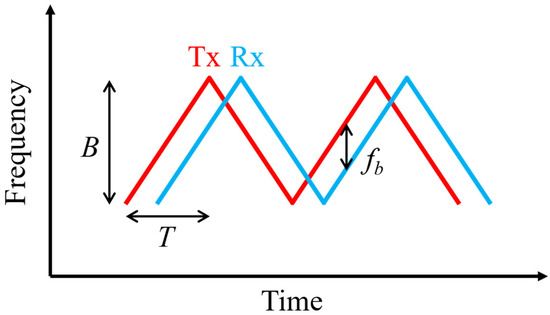
Figure 2.
Transmitted (Tx) and reflected (Rx) chirp signals in an FMCW radar.
Therefore, if the chirp parameters are known, the target distance R can be readily calculated from the beat frequency fb. A shorter chirp duration T enhances real-time performance. High-speed chirping enhances the responsiveness and temporal resolution of the system, which is beneficial for real-time ranging of rapidly moving targets. Moreover, the distance resolution ΔR of an FMCW radar system is given by:
Therefore, generating a wideband chirp signal is essential for achieving high resolution, and the use of THz waves generated by photomixing is well-suited for this purpose. In addition to distance measurement, FMCW radar can also determine the target velocity by extracting the Doppler frequency shift caused by a moving target. The Doppler frequency fd can be expressed in terms of the relative velocity v and the wavelength λ of the transmitted signal as follows:
By separating the Doppler frequency component from the beat frequency, both distance and velocity can be simultaneously estimated.
2.3. Reflection-Type Transversal Filter Laser Diode
In our implementation, a reflection-type transversal filter laser diode (RTF-LD) [38] was used as a high-speed wavelength tunable laser. The RTF-LD enables high-speed control of the lasing wavelength through the electro-optic effect. As shown in Figure 3, its structure consists of an active region (ACT) connected to five delay lines of different lengths via a 1 × 5 multimode interference (MMI) coupler, with the laser output from the ACT-side facet. These five delay lines, each with a different length, form an optical frequency filter. The RTF-LD incorporates four wavelength-tuning electrodes labeled “Red,” “Blue,” “Fine,” and “Phase.” Applying voltages to these electrodes changes the refractive indices of the delay lines via the electro-optic effect. As a result, the optical path length is altered, which changes the characteristics of the RTF and enables wavelength tuning. Unlike conventional current-injection-type tunable lasers, this configuration suppresses thermal drift, enabling high-speed wavelength switching within approximately 500 ps. The “Red” and “Blue” electrodes are used for coarse wavelength tuning, while the “Fine” electrode allows for finer adjustments. In addition, the “Phase” electrode enables even finer and continuous wavelength control. Coordinated control of multiple electrodes enables continuous wavelength tuning across the entire C-band (1530–1565 nm). Furthermore, the RTF-LD consumes less than 10 mW of power during wavelength switching and exhibits a narrow linewidth of 350 kHz. In this study, the “Red,” “Blue,” and “Fine” electrodes were used for tuning the lasing wavelength, while the “Phase” electrode was used for modulation.
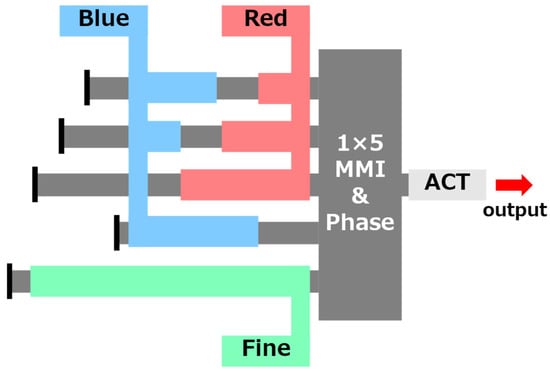
Figure 3.
Schematic diagram of the structure of the RTF-LD.
3. Experimental Setup
3.1. Transmitter Configuration
Figure 4 shows the experimental configuration of the proposed transmitter that integrates FSK communication and FMCW radar in the THz band. First, for FSK signal generation, a voltage pattern consisting of a pseudo-random binary sequence (PRBS) of length 27 − 1 was generated by a pulse pattern generator (PPG) and applied to the wavelength-tuning “Phase” electrode of RTF-LD1. The RTF-LD1 emits a lightwave at an optical frequency of 192.9899 THz when the bit is “1” and 192.9879 THz when the bit is “0”. Next, for the FMCW radar signal generation, a triangular control voltage with a period of 800 ns was generated by a digital-to-analog converter (DAC) and applied to the wavelength-tuning “Phase” electrode of RTF-LD2. As a result, the lasing frequency of RTF-LD2 was swept in a triangular pattern from 192.4648 THz to 192.4727 THz. Then, the lightwave from a fixed-wavelength laser diode (LD) with a lasing frequency of 192.7200 THz was combined with the lightwaves from RTF-LD1 and RTF-LD2 using an optical coupler. These combined lightwaves were subsequently amplified by an erbium-doped fiber amplifier (EDFA), and the amplified spontaneous emission (ASE) noise was removed using an ASE filter (ASEF). Finally, the lightwaves were injected into a UTC-PD as a photomixer. As a result, an FSK signal in the 280 GHz band, corresponding to the frequency difference between RTF-LD1 and LD, and an FMCW radar signal in the 240 GHz band, corresponding to the frequency difference between RTF-LD2 and LD, were simultaneously generated.
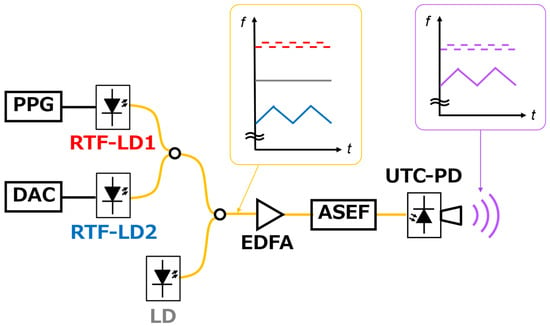
Figure 4.
Experimental setup of the transmitter.
3.2. THz FSK Communication Setup
Figure 5 shows the experimental setup for THz FSK communication. Based on the transmitter configuration described in the previous section, THz waves at 279.9 GHz and 277.9 GHz were generated. These THz signals were transmitted through a WR-3.4 metallic rectangular waveguide. Since signals in the 300-GHz band cannot be directly observed, a sub-harmonic mixer (SHM) was used at the receiver side to mix the incoming THz wave with a local oscillator (LO) signal at 274.1 GHz, which was generated by a signal generator (SG) and a frequency multiplier (×12). The THz waves were then down-converted to an intermediate frequency (IF), resulting in binary frequency-modulated signals at 5.8 GHz and 3.8 GHz. The signal was subsequently amplified by a low-noise amplifier (LNA) and passed through a high-pass filter (HPF) with a cutoff frequency of 3.9 GHz, which removed the lower-frequency 3.8 GHz signal and allowed only the 5.8 GHz signal to pass. Finally, the selected 5.8 GHz signal amplitude was extracted by an envelope detector (DET), thereby converting the 2FSK signal into a baseband ON/OFF waveform, which corresponds to the transmitted data pattern. This signal processing represents a simple demodulation scheme employed for eye-diagram measurement. The signal quality was evaluated using an oscilloscope (OSC) and a bit error rate tester (BERT). The THz-FMCW signal was also generated simultaneously during the THz-FSK communication experiment.

Figure 5.
Experimental setup for THz FSK communication.
3.3. THz FMCW Radar Setup
Figure 6 shows the experimental setup for the THz FMCW radar. The generated THz-FMCW signal was collimated by Lens 1 (L1, focal length F1 = 100 mm) via a horn antenna and split by a beam splitter (BS) in a Michelson interferometer toward a reference mirror and the target. THz waves reflected from each path were then focused by Lens 2 (L2, focal length F2 = 100 mm) and directed into a Fermi-level managed barrier diode (FMBD), where the beat frequency was observed using an OSC. Due to the difference in distance from the BS to the target (R1) and to the reference mirror (R2), a time delay occurred between the two propagation paths of the THz wave, resulting in a beat frequency output from the FMBD. The distance to the reference mirror (R2) was fixed at 6.5 cm, while the target distance (R1) was set to five distances (18.6 cm, 24.3 cm, 27.5 cm, 37.9 cm, and 47.9 cm) for distance measurements. The THz-FSK signal was also generated simultaneously during the THz-FMCW radar experiment.
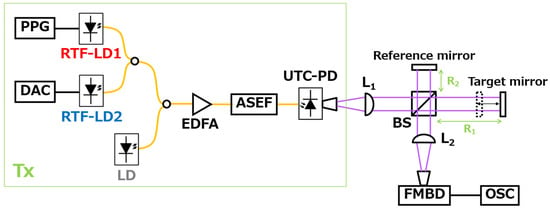
Figure 6.
Experimental setup for THz FMCW radar.
4. Results and Discussions
4.1. THz FSK Communication Performance
Figure 7 shows the measured BER as a function of data rate. The measured BER was 1.5372 × 10−3 at 2 Gbit/s, which falls below the HD-FEC threshold of 3.8 × 10−3. As shown in Figure 8, clear eye diagrams were observed on the OSC at each data rate. The degradation of BER at higher data rates is mainly attributed to the bandwidth limitation of the DET used in our setup. The DET has an output envelope bandwidth of 500 MHz, which limits the accurate demodulation of higher-rate 2FSK signals. We expect that using a DET with a wider bandwidth would reduce the BER. In addition, the achievable data rate in the present system is constrained by the wavelength switching speed of the RTF-LD. However, employing faster tunable lasers or adopting higher-order FSK would allow higher data rates.
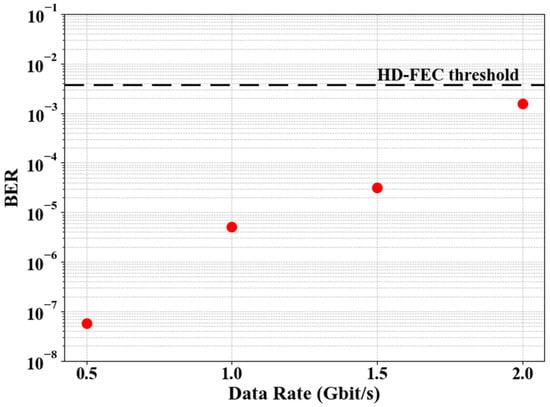
Figure 7.
BER versus data rate.


Figure 8.
Eye diagrams.
These results were obtained while the FMCW signal was also being generated. Figure 9 shows the spectrum of the FSK signal and the FMCW radar signal in the THz band. The spectrum was obtained by observing the IF signal down-converted by an SHM using an electrical spectrum analyzer and processing the data. The two signals appeared at distinct frequency bands, with the FSK signal around 280 GHz and the FMCW radar signal around 240 GHz, and no spectral overlap was observed. This observation demonstrates that both functions can operate simultaneously without interference.
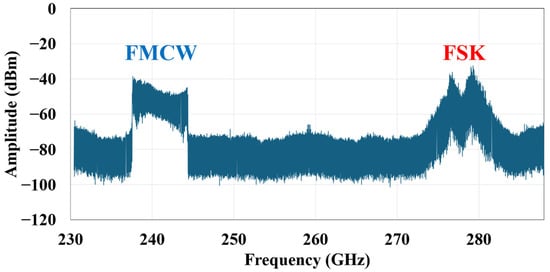
Figure 9.
Spectrum of the FSK and FMCW signals.
4.2. THz FMCW Radar Performance
Figure 10 shows the short-time Fourier transform (STFT) derived from the waveform of the generated FMCW signal. The STFT was obtained from the IF signal down-converted by the SHM. The signal varied periodically with an 800 ns period and a sweep bandwidth of 7.9 GHz, covering the frequency range from 237.3 GHz to 245.2 GHz. These results confirm that a high-speed, triangular frequency-modulated THz-FMCW signal was successfully generated.
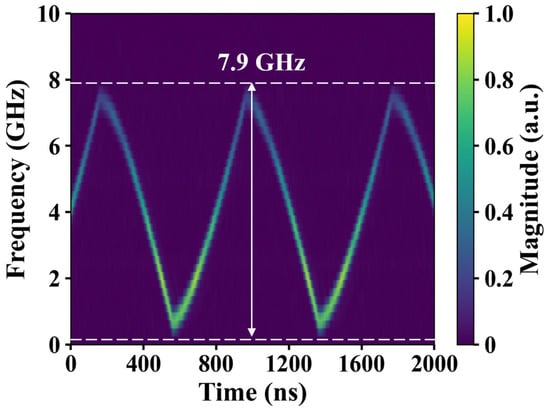
Figure 10.
STFT analysis of FMCW signals.
Figure 11 shows the ranging results obtained by performing a Fourier transform on the beat frequency observed by the FMBD. A clear beat frequency was observed at each measurement point. The distance was calculated from the peak frequency in this spectrum according to Equation (4), while other frequency peaks were negligible for distance calculation. The calculated distances based on these peak frequencies are shown in Figure 12. The ranging error remained on the order of 1 cm at all five measurement points, confirming that high-resolution distance measurement was successfully achieved using the THz-FMCW signal while the communication signal was being transmitted. In this experiment, distance measurement was performed at a distance of several tens of centimeters. However, with sufficient transmitted THz power, longer-distance measurement can also be realized.

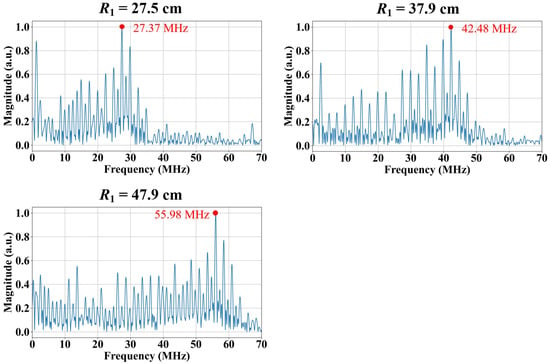
Figure 11.
Fourier transform of beat frequency.
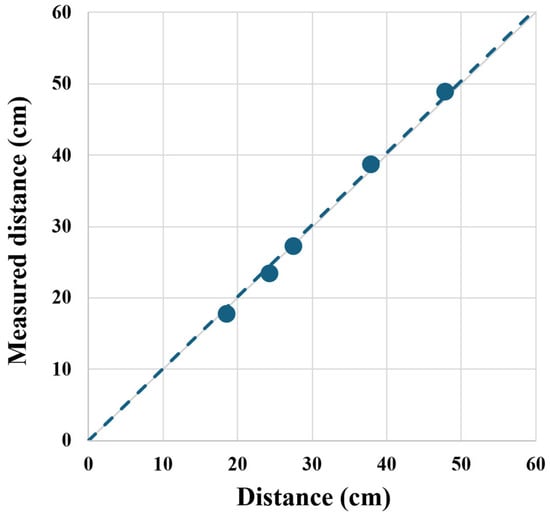
Figure 12.
Distance measurement results.
5. Conclusions
We proposed and experimentally demonstrated a THz-band ISAC system that integrates FMCW radar and FSK communication, enabled by a high-speed wavelength tunable laser. For communication, the system achieved 2 Gbit/s 2FSK transmission in the 280 GHz band with a BER below the HD-FEC threshold. For radar sensing, it successfully generated a THz-FMCW signal in the 240 GHz band with a sweep bandwidth of 7.9 GHz and a short repetition period of 800 ns. In the ranging experiment, a high-resolution distance measurement with an error on the order of 1 cm was successfully achieved.
Author Contributions
Conceptualization, R.K. and K.K.; methodology, R.K., S.Y., Y.W., Y.M., Y.U. and K.K.; validation, R.K., S.Y., Y.W., Y.M. and K.K.; investigation, R.K., S.Y., Y.W., Y.M. and K.K.; resources, Y.U. and K.K.; data curation, R.K.; writing—original draft preparation, R.K.; writing—review and editing, Y.M. and K.K.; visualization, R.K.; supervision, Y.M. and K.K.; project administration, K.K.; funding acquisition, Y.M. and K.K. All authors have read and agreed to the published version of the manuscript.
Funding
This work was supported in part by the commissioned research by the MIC/FORWARD (JPMI241010003), NICT JPJ012368C02801, JPJ012368C00901, and JSPS KAKENHI Grant Number: JP23K17751, JP24H00319.
Institutional Review Board Statement
Not applicable.
Informed Consent Statement
Not applicable.
Data Availability Statement
Data available on request.
Conflicts of Interest
Author Yuta Ueda was employed by the company NTT Corporation. The remaining authors declare that the research was conducted in the absence of any commercial or financial relationships that could be construed as a potential conflict of interest.
References
- Wang, S.; Zhang, X.; Zhang, Y.; Wang, L.; Yang, J.; Wang, W. A Survey on Mobile Edge Networks: Convergence of Computing, Caching and Communications. IEEE Access 2017, 5, 6757–6779. [Google Scholar] [CrossRef]
- Alhammadi, A.; Al-Alawi, R.M.; Jahdhami, M.A.A.; El-Saleh, A.A.; Ismail, Z.H.; Shamsan, Z.A.; Shayea, I. Revolutionizing Mobile Broadband: Assessing Multicellular Networks in Indoor and Outdoor Environments. IEEE Access 2024, 12, 120840–120863. [Google Scholar] [CrossRef]
- Song, H.-J.; Lee, N. Terahertz Communications: Challenges in the Next Decade. IEEE Trans. Terahertz Sci. Technol. 2022, 12, 105–117. [Google Scholar] [CrossRef]
- Song, H.-J.; Nagatsuma, T. Present and Future of Terahertz Communications. IEEE Trans. Terahertz Sci. Technol. 2011, 1, 256–263. [Google Scholar] [CrossRef]
- Akyildiz, I.F.; Han, C.; Hu, Z.; Nie, S.; Jornet, J.M. Terahertz Band Communication: An Old Problem Revisited and Research Directions for the Next Decade. IEEE Trans. Commun. 2022, 70, 4250–4285. [Google Scholar] [CrossRef]
- Elayan, H.; Amin, O.; Shihada, B.; Shubair, R.M.; Alouini, M.S. Terahertz Band: The Last Piece of RF Spectrum Puzzle for Communication Systems. IEEE Open J. Commun. Soc. 2019, 1, 1–32. [Google Scholar] [CrossRef]
- Huq, K.M.S.; Busari, S.A.; Rodriguez, J.; Frascolla, V.; Bazzi, W.; Sicker, D.C. Terahertz-Enabled Wireless System for Beyond-5G Ultra-Fast Networks: A Brief Survey. IEEE Netw. 2019, 33, 89–95. [Google Scholar] [CrossRef]
- Yu, X.; Chen, Y.; Galili, M.; Morioka, T.; Jepsen, P.U.; Oxenløwe, L.K. The prospects of ultra-broadband THz wireless communications. In Proceedings of the 16th International Conference on Transparent Optical Networks (ICTON), Graz, Austria, 6–10 July 2014. [Google Scholar] [CrossRef]
- Nagatsuma, T.; Oogimoto, K.; Yasuda, Y.; Fujita, Y.; Inubushi, Y.; Hisatake, S.; Martinez Agoues, A.; Crespo Lopez, G. 300-GHz-band wireless transmission at 50 Gbit/s over 100 meters. In Proceedings of the 41st International Conference on Infrared, Millimeter, and Terahertz Waves (IRMMW-THz), Copenhagen, Denmark, 25–30 September 2016. [Google Scholar] [CrossRef]
- Liu, K.; Jia, S.; Wang, S.; Pang, X.; Li, W.; Zheng, S.; Chi, H.; Jin, X.; Zhang, X.; Yu, X. 100 Gbit/s THz Photonic Wireless Transmission in the 350-GHz Band With Extended Reach. IEEE Photonics Technol. Lett. 2018, 30, 1064–1067. [Google Scholar] [CrossRef]
- Li, X.; Yu, J.; Zhao, L.; Zhou, W.; Wang, K.; Kong, M.; Chang, G.-K.; Zhang, Y.; Pan, X.; Xin, X. 132-Gb/s Photonics-Aided Single-Carrier Wireless Terahertz-Wave Signal Transmission at 450 GHz Enabled by 64QAM Modulation and Probabilistic Shaping. In Proceedings of the Optical Fiber Communication Conference and Exhibition (OFC), San Diego, CA, USA, 3–7 March 2019. [Google Scholar] [CrossRef]
- Lai, Z.; Li, C.; Li, Y.; Lai, X.; Li, J.; Guan, K. A High-order Modulation (64-QAM) Broadband THz Communication System over 100 Gbps. In Proceedings of the 2021 IEEE 4th International Conference on Electronic Information and Communication Technology (ICEICT), Xi’an, China, 18–20 August 2021. [Google Scholar] [CrossRef]
- Zhang, H.; Yang, Z.; Lyu, Z.; Yang, H.; Zhang, L.; Ozolins, O.; Pang, X.; Zhang, X.; Yu, X. 300 GHz photonic-wireless transmission with aggregated 1.034 Tbit/s data rate over 100 m wireless distance. In Proceedings of the Optical Fiber Communication Conference and Exhibition (OFC), San Diego, CA, USA, 24–28 March 2024. [Google Scholar] [CrossRef]
- Bhutani, A.; Marahrens, S.; Gehringer, M.; Göttel, B.; Pauli, M.; Zwick, T. The Role of Millimeter-Waves in the Distance Measurement Accuracy of an FMCW Radar Sensor. Sensors 2019, 19, 3938. [Google Scholar] [CrossRef]
- Li, Y.; Kaname, R.; Mizuno, R.; Li, Y.; Fujita, M.; Ito, H.; Nagatsuma, T. Ultra-Wideband Frequency Modulated Continuous Wave Photonic Radar System for Three-Dimensional Terahertz Synthetic Aperture Radar Imaging. J. Light. Technol. 2022, 40, 6719–6728. [Google Scholar] [CrossRef]
- Zhang, H.; Wang, S.; Jia, S.; Yu, X.; Jin, X.; Zheng, S.; Chi, H.; Zhang, X. Experimental generation of linearly chirped 350 GHz band pulses with a bandwidth beyond 60 GHz. Opt. Lett. 2017, 42, 5242–5245. [Google Scholar] [CrossRef] [PubMed]
- Liebermeister, L.; Nellen, S.; Kohlhaas, R.B.; Lauck, S.; Deumer, M.; Breuer, S.; Schell, M.; Globisch, B. Optoelectronic frequency-modulated continuous-wave terahertz spectroscopy with 4 THz bandwidth. Nat. Commun. 2021, 12, 1071. [Google Scholar] [CrossRef] [PubMed]
- Sengupta, N.; Grzeslo, M.; Iwamatsu, S.; Tebart, J.; Haddad, T.; Stöhr, A. Ultra-Broadband Photonic THz Transceiver IC for High Range-Resolution FMCW RADAR. In Proceedings of the 4th URSI Atlantic Radio Science Meeting (AT-RASC), Meloneras, Spain, 19–24 May 2024. [Google Scholar] [CrossRef]
- Mohammadzadeh, S.; Keil, A.; Kocybik, M.; Schwenson, L.M.; Liebermeister, L.; Kohlhaas, R.; Globisch, B.; von Freymann, G.; Seewig, J.; Friederich, F. Extreme Ultra-Wideband Optoelectronic Frequency-Modulated Continuous-Wave Terahertz Radar. Laser Photonics Rev. 2023, 17, 2300396. [Google Scholar] [CrossRef]
- Ye, S.; Wang, Y.; Li, B.; Kaide, R.; Che, M.; Mikami, Y.; Ueda, Y.; Kato, K. Photonic Generation of Crossed-dual-chirp THz LFM Signal by Single Tunable Laser. IEEE Photonics Technol. Lett. 2025, 37, 1269–1272. [Google Scholar] [CrossRef]
- Rappaport, T.S.; Xing, Y.; Kanhere, O.; Ju, S.; Madanayake, A.; Mandal, S.; Alkhateeb, A.; Trichopoulos, G.C. Wireless Communications and Applications Above 100 GHz: Opportunities and Challenges for 6G and Beyond. IEEE Access 2019, 7, 78729–78757. [Google Scholar] [CrossRef]
- Jia, S.; Wang, S.; Liu, K.; Pang, X.; Zhang, H.; Jin, X.; Zheng, S.; Chi, H.; Zhang, X.; Yu, X. A Unified System With Integrated Generation of High-Speed Communication and High-Resolution Sensing Signals Based on THz Photonics. J. Light. Technol. 2018, 36, 4549–4556. [Google Scholar] [CrossRef]
- Wang, Y.; Li, W.; Ding, J.; Zhang, J.; Zhu, M.; Zhao, F.; Wang, M.; Yu, J. Integrated High-Resolution Radar and Long-Distance Communication Based-on Photonic in Terahertz Band. J. Light. Technol. 2022, 40, 2731–2738. [Google Scholar] [CrossRef]
- Sümen, G.; Kurt, G.K.; Görçin, A. A Novel LFM Waveform for Terahertz-Band Joint Radar and Communications over Inter-Satellite Links. In Proceedings of the 2022 IEEE Global Communications Conference (GLOBECOM), Rio de Janeiro, Brazil, 4–8 December 2022. [Google Scholar] [CrossRef]
- Che, M.; Li, B.; Tang, H.; Ye, S.; Kamiura, Y.; Kato, K. Photonic Generation of Joint Amplitude-Frequency Modulated Waveform for THz Integrated Sensing and Communication. Microw. Opt. Technol. Lett. 2025, 67, e70216. [Google Scholar] [CrossRef]
- Yamazaki, H.; Nagatani, M.; Wakita, H.; Ogiso, Y.; Nakamura, M.; Ida, M.; Nosaka, H.; Hashimoto, T.; Miyamoto, Y. IMDD Transmission at Net Data Rate of 333 Gb/s Using Over-100-GHz-Bandwidth Analog Multiplexer and Mach–Zehnder Modulator. J. Light. Technol. 2019, 37, 1772–1778. [Google Scholar] [CrossRef]
- Ye, S.; Masutomi, N.; Li, B.; Kamiura, Y.; Kaide, R.; Doi, R.; Wang, Y.; Che, M.; Mikami, Y.; Ueda, Y.; et al. Ultra-fast photonic frequency hopping driven by reflection-type transversal filter laser for anti-jamming terahertz communications. Opt. Lett. 2025, 50, 3070–3073. [Google Scholar] [CrossRef]
- Jia, S.; Zhang, L.; Wang, S.; Li, W.; Qiao, M.; Lu, Z.; Idrees, N.M.; Pang, X.; Hu, H.; Zhang, X.; et al. 2 × 300 Gbit/s Line Rate PS-64QAM-OFDM THz Photonic-Wireless Transmission. J. Light. Technol. 2020, 38, 4715–4721. [Google Scholar] [CrossRef]
- He, D.; Wang, Z.; Quek, T.Q.S.; Chen, S.; Hanzo, L. Deep Learning-Assisted TeraHertz QPSK Detection Relying on Single-Bit Quantization. IEEE Trans. Commun. 2021, 69, 8175–8187. [Google Scholar] [CrossRef]
- Moon, S.-R.; Sung, M.; Lee, J.K.; Cho, S.-H. Cost-Effective Photonics-Based THz Wireless Transmission Using PAM-N Signals in the 0.3 THz Band. J. Light. Technol. 2020, 39, 357–362. [Google Scholar] [CrossRef]
- Ding, J.; Kong, M.; Wang, K.; Yu, J. THz PAM-4 signal generation by a modulator driven by binary scheme with different driving voltages. Opt. Fiber Technol. 2020, 60, 102360. [Google Scholar] [CrossRef]
- Shrestha, R.; Guerboukha, H.; Fang, Z.; Knightly, E.; Mittleman, D.M. Jamming a terahertz wireless link. Nat. Commun. 2022, 13, 3045. [Google Scholar] [CrossRef]
- Nagatsuma, T. Photodetectors for Microwave Photonics. In Photodetectors; Elsevier: Amsterdam, The Netherlands, 2023; pp. 467–484. [Google Scholar]
- Nagatsuma, T.; Gao, W.; Kawamoto, Y.; Ohara, T.; Ito, H.; Ishibashi, T. InP-based Integrated Circuits on SiC/Si Substrates for Terahertz Communications. J. Light. Technol. 2025. Early Access. [Google Scholar] [CrossRef]
- Ishibashi, T.; Ito, H. Uni-traveling-carrier photodiodes. J. Appl. Phys. 2020, 127, 031101. [Google Scholar] [CrossRef]
- Jia, S.; Lo, M.C.; Zhang, L.; Ozolins, O.; Udalcovs, A.; Kong, D.; Pang, X.; Guzman, R.; Yu, X.; Xiao, S.; et al. Integrated dual-laser photonic chip for high-purity carrier generation enabling ultrafast terahertz wireless communications. Nat. Commun. 2022, 13, 1388. [Google Scholar] [CrossRef] [PubMed]
- Tomimura, Y.; Satou, A.; Kita, T. Generation of Millimeter Waves and Sub-Terahertz Waves Using a Two-Wavelength Tunable Laser for a Terahertz Wave Transceiver. Photonics 2024, 11, 811. [Google Scholar] [CrossRef]
- Ueda, Y.; Saito, Y.; Shindo, T.; Kanazawa, S.; Kobayashi, W.; Matsuzaki, H.; Ishikawa, M. Hitless Wavelength Switching of Semiconductor Optical Amplifier-Integrated Reflection-Type Transversal Filter Laser With Suppressed Frequency Error. J. Light. Technol. 2023, 41, 2765–2774. [Google Scholar] [CrossRef]
Disclaimer/Publisher’s Note: The statements, opinions and data contained in all publications are solely those of the individual author(s) and contributor(s) and not of MDPI and/or the editor(s). MDPI and/or the editor(s) disclaim responsibility for any injury to people or property resulting from any ideas, methods, instructions or products referred to in the content. |
© 2025 by the authors. Licensee MDPI, Basel, Switzerland. This article is an open access article distributed under the terms and conditions of the Creative Commons Attribution (CC BY) license (https://creativecommons.org/licenses/by/4.0/).